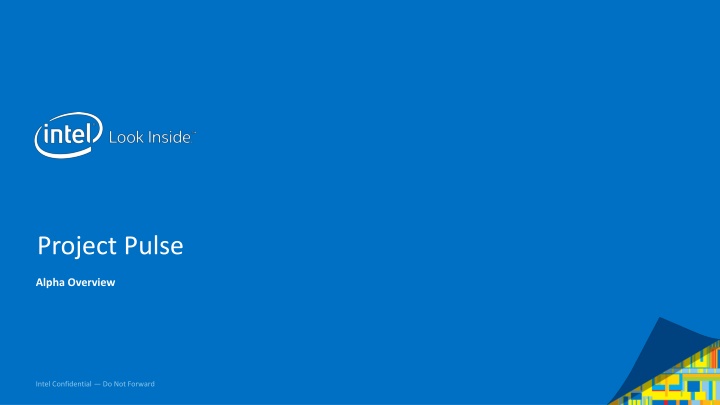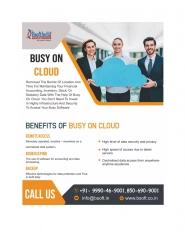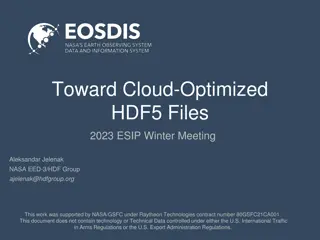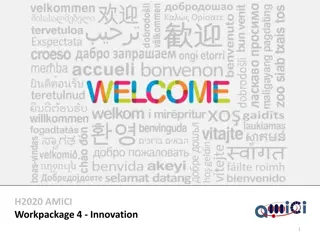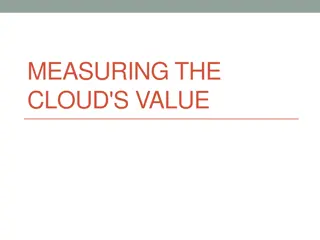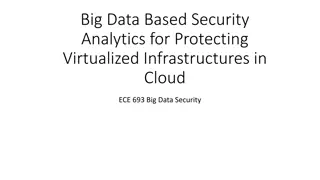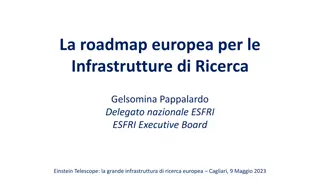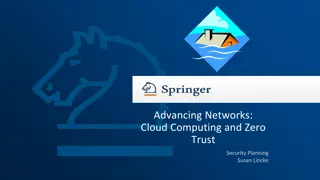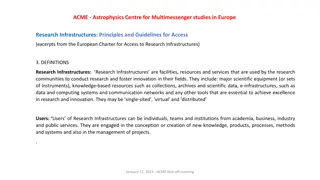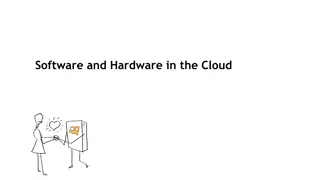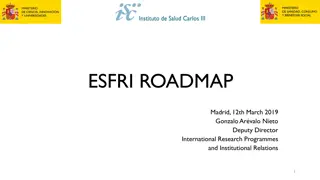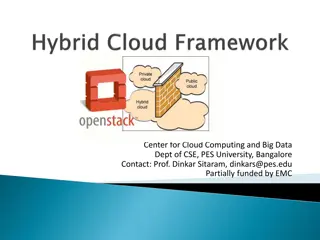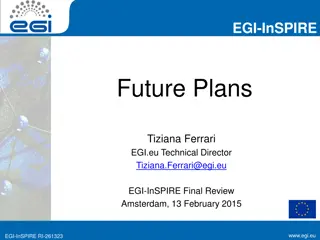Future Infrastructures Are Software Defined: Evolution from Mainframes to Cloud
The evolution of infrastructures from mainframes to cloud computing, with a focus on software-defined technologies. Discover how intelligent resource orchestration and advanced technologies shape the modern cloud landscape."
Download Presentation

Please find below an Image/Link to download the presentation.
The content on the website is provided AS IS for your information and personal use only. It may not be sold, licensed, or shared on other websites without obtaining consent from the author.If you encounter any issues during the download, it is possible that the publisher has removed the file from their server.
You are allowed to download the files provided on this website for personal or commercial use, subject to the condition that they are used lawfully. All files are the property of their respective owners.
The content on the website is provided AS IS for your information and personal use only. It may not be sold, licensed, or shared on other websites without obtaining consent from the author.
E N D
Presentation Transcript
Project Pulse Alpha Overview Intel Confidential Do Not Forward
Future Infrastructures Are Software Defined Future Infrastructures Are Software Defined 1960s 1990s 2000s 2010s MAINFRAMES CLIENT + SERVER WEB CLOUD
Cloud Computing Growth & Market Dynamics Cloud computing is the fastest growing segment of the data center business Annual Intel CPU Sales Private Cloud Tier 2 CSP Tier 1 CSP 2009 2010 2011 2012 2013 2014 Intel Internal Only
Intelligent Resource Orchestration LEARN WATCH COLLECT Expose platform/app data through APIs DECIDE Analytics to define correct response LEARN LEARN WATCH DECIDE ACT ACT Mechanisms for policy activation APP LEARN SERVER / STORAGE / NETWORK Machine learning for continuous improvement LEARN
Technologies that help us shape the cloud Cloud Software Stack Applications & Services Developer Environment Cloud Software Orchestration Software Telemetry and Datacenter Analytics Virtualization Software Operating System, Libraries Server Silicon Network Silicon Storage Silicon Intel Internal Only
Assumptions for building Pulse 1. Platform telemetry can influence infrastructure management for new cloud stacks. 2. Exposing IA telemetry both enables #1 and creates Intel value via unique platform telemetry. 3. Historically IA telemetry has been exposed in a limited, non-uniform, and difficult to consume format for cloud platforms. 4. Making IA telemetry easy to consume for a broad set of cloud use cases will drive preference for IA. 6
Pulse Overview What is it? A powerful telemetry agent framework designed to Improve deployment model and flexibility of the telemetry tools ecosystem Provide dynamic control of collection for small or large clusters of systems Allow flexible processing of telemetry data on agent (e.g. machine learning) Simplify disseminating data to telemetry ingesting systems Provide operational innovation for collecting across cluster of machines Support emerging API consumption models 7
Pulse Overview What it isnt Pulse is not intended to Operate as an analytics platform It is intended to feed them Compete with existing metric/monitoring/telemetry agents 8
The Workflow Publish into domains Process and normalize Collect data Orchestration & Scheduling Filter Monitoring Learn Billing/Chargeba ck Convert 9
The Plugin Model Processor Collector Publisher 10
Pulse Overview Collect Consume telemetry data through plugins 1. Built-in plugins for leveraging existing telemetry ecosystem (Facter, CollectD, Ohai) 2. Specific plugins for consuming Intel telemetry (Node, DCM, NIC, Disk) 3. Open model for third party plugins 4. Organized telemetry catalog dynamically generated from plugins 5. Make discovering available telemetry easy through dynamic documentation, APIs, and more 6. Make consuming telemetry declarative 11
Pulse Overview Process Extensible workflow injection Convert telemetry into another data model for consumption by existing telemetry consumption systems (like OpenStack Ceilometer) Allows encryption of all or part of the telemetry payload before publishing. Inject remote queries into workflow for tokens, filtering, etc. Implement filtering at an agent level reducing injection load on telemetry consumer 12
Pulse Overview Publish Sink telemetry into a wide array of systems Decouple the collection of IA telemetry from the implementation of where to send it. A large library of publisher plugins allow exposure to telemetry analytics systems both customer and common. Makes Pulse valuable in the way it enables and cooperates with existing systems. Make Pulse valuable to open source and commercial ecosystems by allow them to build a publisher into their architectures. 13
The Catalog Expose telemetry in a unified catalog /intel/server/cpu/load /intel/server/cpu/ipc Intel IPC Intel MEM Intel NIC /intel/server/cpu/l2cache /intel/server/mem/free /intel/server/mem/used /intel/server/nic/eth0/bytes_rec Query: Show me all /intel/server/* 14
Example Influx & Grafana OpenStack Ceilometer Ceilometer Ceilometer OpenStack OpenStack OpenStack Oslo Adapter Adapter OpenStack Oslo Publisher RabbitMQ RabbitMQ OpenStack Oslo Adapter Metric Query Metric Query Metric Query Collector RabbitMQ Processor CPU NIC NIC MEM CPU CPU MEM MEM Publisher 15
Plugin Lifecycle Plugin load Dynamic, does not require restart Automatically is informed by plugin on the features, metrics, and configuration detail. Dynamically extends the metric catalog when loaded. Plugin unload Removes metrics from catalog automatically. Plugin swap Swaps a newer version plugin for an old one in a safe transaction
Plugin Lifecycle Loading a new plugin automatically upgrades running workflows in tasks. Unless the collection is pinned to a version (ex: get /intel/server/cpu/load/v1) Each scheduled workflow automatically uses the most mature plugin for that step. Coupled with dynamic plugin loading results in instantaneous updates to existing workflows. Helpful for bug fixes, security patching, improving accuracy.
Open Plugin Ecosystem Intel Built-in IA specific exposure of telemetry Common processing hooks: OSLO, Machine Learning, Filtering Common open source bus and persistent models: RabbitMQ, ,Mosquito, File, DB
Open Plugin Ecosystem Support for external open source plugins Plugins are built isolated from pulse itself Allows ecosystem to add plugin building for specific projects into the project. Plugins can be built externally and loaded/shared widely.
Open Plugin Ecosystem Commercial plugin use supported Plugin can be distributed Once built the plugins can be shared as part of a commercial product licensed separately from Pulse. Works well for vendors like VMware, SAP, etc. Binary builds keep source code private.
The API Current: Full control through REST API on pulsed pulsectl CLI tool for managing pulsed remotely REST API support for HTML5 SSE streaming Beta TRIBE (management clustering) Webconsole 21
Example Deployment Scenarios Host: All-in-One Physical/VM Distributed And Decoupled Collection Host: Physical or Virtual Scheduler Host: Host: Host: Host: Physical/VM Physical/VM Physical/VM Physical/VM Collection Scheduler Collection Publishing Processing Processing Publishing Host: Physical/VM Collection 27
DEMO 28
Next Steps Demos to our demo guest list (Intel internal) Beta phase Flexible deployment model TRIBE clustering AAA (security) Plugin signing Other features, based on feedback 29
Create Value, Creating Preference for IA 1. Make unique telemetry from Intel Architecture available and easy to consume 2. Tie telemetry to smarter decisions (better workload placement, more efficiency, predictive systems) 3. Associate developing on IA with ease of use & decrease in OpEx 4. Drive discussion for future platforms & develop insight for what telemetry is valuable. 30
Create Value, Creating Preference for IA 1. Make unique telemetry from Intel Architecture available and easy to consume 2. Tie telemetry to smarter decisions (better workload placement, more efficiency, predictive systems) 3. Associate developing on IA with ease of use & decrease in OpEx 4. Drive discussion for future platforms & develop insight for what telemetry is valuable. MSS & ASP expansion and protection Attach silicon value & avoid abstraction 31
Deployment Models 1. Open Platform - Full Open Source (Apache license) Pulse agent code distributed and supported in open source community Intel-supported plugins packaged and licensed with platform Community plug-ns expected to be developed independent of Intel SDK published and maintained by Intel Integration work for Openstack Ceilometer and Docker ecosystem Can be integrated by CSPs (e.g. Cloud Foundry) 2. Proprietary Platform - Enable OEM & ISV differentiation (VMWare, SAP) Pulse agent code distributed by ISV, ecosystem partners, or deployed directly by end customer Option for ISV ecosystem partners to create custom/proprietary plug-ins 3. Custom Platform Enable large scale datacenter and service provider solutions Pulse plug-ins developed by each customer for their unique platform Allows custom consumer to specialize above or alongside supported or community plugins AWS, Google, Digital Ocean 32
Pulse Overview Publish 1. Capable of publishing data to single or multiple endpoints 1. RabbitMQ 2. Ceilometer 3. vCops 4. InfluxDB 33
Pulse Overview Example Workflows Customizable definition of task and related workflow: Publish Collect Publish Collect Process Publish Process Publish Collect Collect Publish Process Publish
Pulse Overview Architecture Core framework for scheduling and workflow management Plugins make Pulse Pulse is extensible through plugins for collection, processing, and publishing of metric data 35
Pulse Overview Core Architecture 1. Scheduler 1. Create/Delete tasks 2. Schedule tasks 2. Manage Plugins 1. Types: Collect, Process, Publish 2. Load/Unload plugins 3. Catalog metrics 4. Start/Stop plugins 3. Rest API 36
Simple and Flexible Deployment Simple Deployments A single binary to install the framework Scheduling tasks, Collection, Processing, Publishing Plugins can be automatically detected Flexible Deployments Easy all-in-one Scheduling tasks, Collecting, Processing and Publish on a single host Distributed Components can be deployed independently on separate hosts Enables complex scenarios processing and publishing for a group of hosts go through specific hosts 37
Example Deployment Scenarios Host: All-in-One Physical/VM Distributed And Decoupled Collection Host: Physical or Virtual Scheduler Host: Host: Host: Host: Physical/VM Physical/VM Physical/VM Physical/VM Collection Scheduler Collection Publishing Processing Processing Publishing Host: Physical/VM Collection 38
API Enabling Custom Integration API Define tasks and workflows Collect -> Process -> Publish Select schedule (Interval, Window, Cron) Manage plugins Load/Unload/Swap Stop/Start Hits, Misses, Errors Set plugin routing strategy (round-robin, most recently used, ) File Configuration files Define tasks and workflows Configure plugins
Custom Integration 1. 2. 3. Host/VM is provisioned Pulse is installed via native installer Pulse is configured through either config file(s) or direct API calls
Custom Integration 1. 2. Event is created by X Service Event is sourced by event consumer that integrates with Pulse through API
